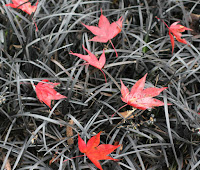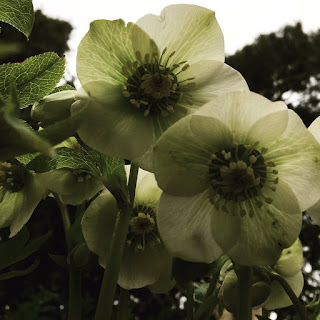 |
| By Nicola ‘Froggie’ Rathbone |
I studied Latin at Secondary school. Not because I wanted to but because I had to at the time. Bam bas bat bamus batis bant. For some reason this has stuck in my head, as has ego sum (I am ) and salve magistra (greetings teacher). I never thought it would be of use to me until I became a gardener. It has been of great help in learning and more about plants and I am going to try and explain why and how you too can discover more about plants.
To start with. It’s not just Latin you will come across but Greek and Arabic derived words too. I am asked regularly, why can we not just use the common names? Why, because it helps to avoid confusion. We need a universal name, one it will be known by, the world over and then anyone, anywhere will know just which plant is being referred to. Take for example, the bluebell. We all know what it looks like in England, right? The Greek/Latin name is Hyacinthoides-non-scripta (Gobbledeygook you may think!) Cross into Scotland and if you asked to see a bluebell you may be directed to a Campanula rotundifolia (which the English would call the harebell). Fly over to North America and the bluebell is now Mertensia virginiana and in Australia, bluebell has got to be Sollya heterophylla. That’s four different plants with the same common name. Now that’s confusing.
Back to the Latin/Greek/Arabic derived names. Think of them as providing
 |
| Bluebells… |
you with more information about the plant. Clues as to which country the plant came from or perhaps the first person to see it growing in the wild. The name often describes the appearance of the leaves and the flowers and the habitat you would need to replicate if you want to grow it in your garden. The names may feature characters and narrate stories from Greek mythology and honour people of note through history. Many English words are derived from Latin, Greek and Arabic and you will be surprised at how much you can actually understand. Now, back to bluebell. The English one. Hyacinthoides non-scripta. Here’s your challenge if you have time and want to know more and here’s a clue. Hyacinthus was a tragic Spartan prince and ‘non scripta’ means no writing . The rest of the story and how the English bluebell got this name is on the internet or in the library. If you would rather not and do not have time then when you next explore the garden look out for the following used to describe plants in some way.
 |
| Victoria amazonica |
Geographical speaking, these describe where the plant originated from.
amazonica-of the Amazon basin (Victoria amazonica) the giant waterlily and in honour of Queen Victoria
arabica -of Arabia (Coffea arabica) coffee
bristoliensis-of Bristol (Sorbus bristoliensis) Bristolian whitebeam
The habitat where the plant was grow in the wild.
maritima -by the sea (Crambe maritima) sea kale
montana -of mountains (Hypericum montanum)
sylvatica-of woods (Fagus sylvatica) beech
The growth habit of the plant.
arboreum-tree like (Aeonium arboreum ‘Swartzkopf’)
fastigiata -fastigiate/erect (Taxus baccata ‘Fastigiata’) upright yew
procumbens -procumbent/creeping (Fuchsia procumbens)
 |
The leaves of Acer palmatum on
Ophiopogon planiscapus ‘Nigrescens’ |
Describe the leaf shape and the edge of the leaf. Also the size, texture and colour. The Latin phylla(um)(us) and folia(ium)(ius) mean leaf.
microphylla-small leaved (Fuchsia microphylla)
palmatum-palm shaped (Acer palmatum)
trifoliata-3 parts to leaf (Menyanthes trifoliata) bogbean
Describe the flower shape, size, colour and flowering time. The Latin flora(um)(us) means flower.
grandiflora-large flowered (Magnolia grandiflora)
stellata-starry (Magnolia stellata)
vernus -spring flowering (Lathyrus vernus)
Describes the colour of leaves, flowers, wood.
nigrescens-black (Opiopogon planiscapus ‘Nigrescens’) black lily turf
purpureus-purple (Salvia officinalis ‘Purpureus’) purple leaved sage
sanguineum-blood red (Geranium sanguineum) bloody cranesbill
Describe scent and aroma of leaves, flowers, bark:-
citriodora-lemon scented (Aloysia citriodora) lemon verbena
fragrantissima-most fragrant (Lonicera x fragrantissima) honeysuckle
odoratus-sweet smelling (Lathyrus odoratus) sweet pea
Describe plants that have flowers or leaves that look like those of other plants:-
liliiflora-lily flowered (Magnolia liliiflora)
pseudoplatanus -false plane (Acer pseudoplatanus) sycamore tree
tulipifera-tulip like (Liriodendron tulipifera) tulip tree
Commemorative:-Named after botanists, plant hunters and for others, such as family members.
hookeriana– after Sir Joseph Hooker (Sarcococca hookeriana)
whiteana – after James Walter white (Sorbus whiteana)
Banksia– after Sir Joseph Banks (Banksia marginata)
 |
| Helleborus x hybridus |
Miscellaneous descriptions:-
communis-common (Juniperus communis) juniper
hybrida-hybrid (Helleborus x hybridus)
officinale-of the shop, herbal (Sachorum officinale) sugarcane
sativa-sown, planted or cultivated (Eruca sativa) rocket
vulgare-common (Oreganum vulgare) common oregano or marjoram
Incidentally on your visit to the garden you will find that in the garden herbal displays, the plants tend to be also labelled with the common names, as they are known in their country of origin. Not all plants have a common name as we know it. Even in this text there are plants that do not have a common name and maybe you could suggest a few after visiting the garden! If you are interested then search out a copy of the little black book, Plant Names Simplified, Botanical Latin by WT Stearn and the glossary of a copy of Hillier’s Manual of Trees and Shrubs. Or any of the other good books out there on plant names.
Hope to see you soon,





